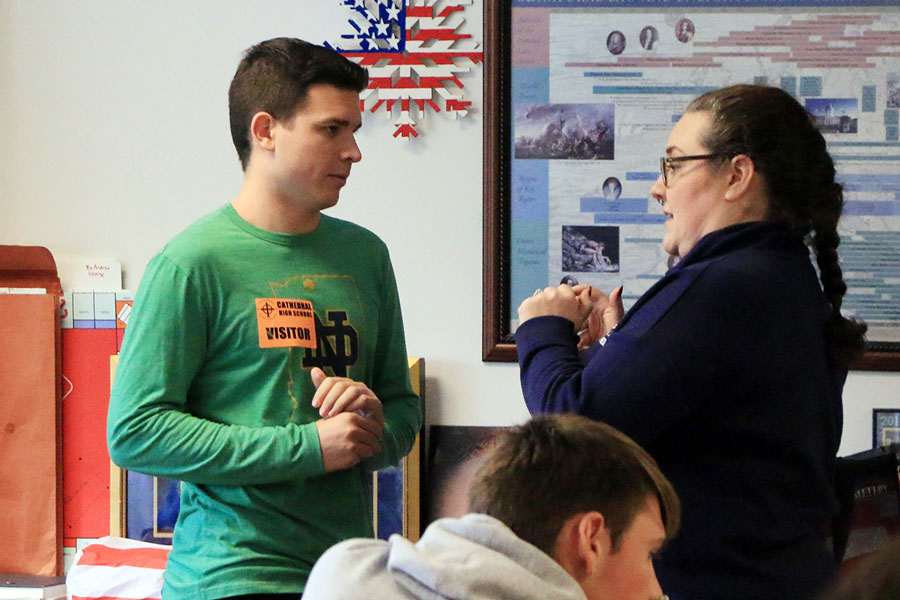Social studies teacher explains Electoral College
Popular vote winner does not necessarily win the Presidency
Social studies teacher Mrs. Jill Twilleager talks to former We the People team member Stephen Vukovits during one of his post-graduation visits to campus. Twilleager explained the Electoral College and why the person who receives the most votes for President is not necessarily the candidate who takes office.
Over the last few weeks since the Nov. 3 election, social studies teachers have given a real-life lesson in politics, history and government, with several teachers explaining why the popular vote is not what determines who moves into the White House on Jan. 20.
Dec. 8 is the deadline for all 50 states to finalize their vote totals and election results. That process then moves to the Electoral College. Social studies teacher Mrs. Jill Twilleager said, “The idea behind the Electoral College, which was created in Article II of the Constitution, was to help safeguard the presidential election from an uneducated populace. Uneducated is not meaning illiterate or stupid but refers to an uneducated populace about politics and people who would be good social leaders.
“The thought was that instead of allowing a general popular vote that they would look at those popular results but each state would have a certain number of people who would be in the official count to become president.”
When the Electoral College was created in the 1800s, it also protected the people from an uneducated populace regarding the selection of candidates. Twilleager said that a “lack of transportation and lack of communication” led to people being unable to know candidates outside their own state. With only a popular vote, candidates from more populated states were much more likely to win, putting smaller states at a disadvantage.
Twilleager said, “By adding the Electoral College, it helps equalize the bigger states to smaller states. Each state is given the number of electors that is equal to the number of people that the state has in the House of Representatives and the Senate. This means that every state has a minimum of three electors because every state has two Senators and at least one member of the House of Representatives.
“When you add up all the Electoral College votes, the idea is that you have to have a majority. We have 435 members of the House and 100 Senators, so that is 535 votes.”
Washington, D.C. was granted three electoral votes in the 23rd Amendment, making the total number of electoral votes 538. To win by a majority, a candidate must get 270 electoral votes.
As she watched the map of Electoral College votes on election night, Twilleager said, “The assumption is that all of the electors will vote for who the state’s popular vote was. We call that the winner take all system. In 48 out of the 50 states, they have a winner take all system.” Nebraska and Maine are the only two states that are able to split their electoral college votes between candidates.
It is the Electoral College, which social studies students have learned over the last few weeks, that explains why a candidate for president (George W. Bush in 2000 and Donald Trump in 2016, for example) can lose the popular vote but be elected.

Senior Emma Kress is a reporter on the Megaphone staff. She runs cross-country and participates in crew for theater. Outside of school, she participates...








Susan Anthony • Dec 1, 2020 at 1:49 PM
Most Americans think it is wrong that the candidate with the most national popular votes can lose a presidential election.
We don’t allow this in any other election in our representative republic.
The National Popular Vote bill is 73% of the way to guaranteeing the majority of Electoral College votes and the presidency to the candidate who receives the most popular votes in the country.
The bill changes state statewide winner-take-all laws (not mentioned in the U.S. Constitution, but later enacted by 48 states), without changing anything in the Constitution, using the built-in method that the Constitution provides for states to make changes.
It requires enacting states with 270 electoral votes to award their electoral votes to the winner of the most national popular votes.
All votes would be valued equally in presidential elections, no matter where voters live.